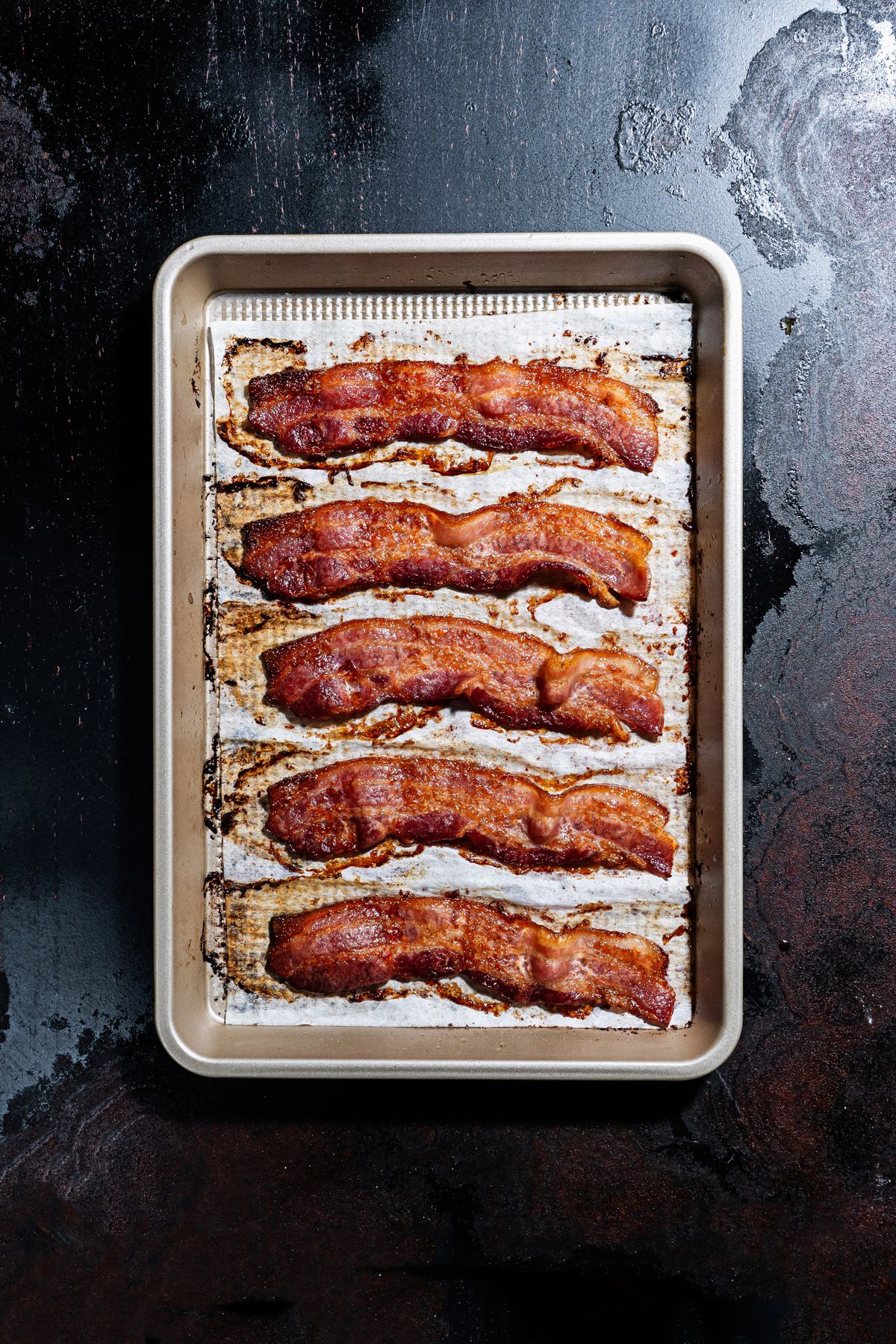The best ways to achieve crispy bacon

I love bacon. While I agree that it shouldn’t go on everything, I welcome the moments when I get to enjoy it in all its crisp, smoky glory such as in my colleague G. Daniela Galarza’s winter BLT from her Eat Voraciously newsletter or on a breakfast plate alongside hash browns and a pair of picture-perfect sunny-side up eggs.
For me, the epitome of this cured pork product is audible crispiness. You might be a fan of some chew or tenderness, which is fine by me because that’s your business, but I want there to be a snap and crunch each time a strip passes my lips. For those of the same mindset, here are two methods to produce just that.
Stove top
Tried and true, this is the way I learned to cook bacon: Lay the strips in a cold skillet, place over medium-low to medium heat, flip and fry until you reach your desired doneness and then transfer to a plate lined with paper towels to drain.
The key is to slowly render the fat to achieve bacon’s character-defining crispness. Unless you walk away from the stove while cooking – which you should not be in the practice of doing outside a handful of situations anyway – this method produces superior results every time.
When it comes to skillet choice, nonstick or cast iron are my recommendations. I prefer a good nonstick skillet for more even heating and thus cooking, but some love the nostalgia of bacon frying in a cast-iron skillet, which is also a great way to season it from time to time.
(And just a reminder about one of the myths of cast iron: While it is great at heat retention, it is a poor conductor, meaning that it will heat unevenly, leading to hot spots and varied textures in the bacon.)
You may have heard of the water method, and you may be wondering about its merits. For those not in the know, the editors at Cook’s Illustrated recommend adding enough water to cover the bacon in the skillet at the start, which leads to a “crispy and tender bite.” While it does produce a slightly less shatteringly crisp end result, I didn’t notice enough of a difference to champion this method over cooking it naked.
The main downside to the stove-top method is the quantity of bacon that you can cook. Unless you have a large griddle that fits across multiple burners, a skillet can only hold enough strips to feed two, maybe three, bacon-loving humans. Plus, if you are prone to get distracted easily and don’t want to stand near the stove, there’s risk of the pork belly going from beautiful to burned in no time at all. That’s where the oven enters.
Oven
Plain and simple, this is the best way to cook bacon for a crowd – or just any time you want to take a more hands-off approach. Lay the bacon on a rimmed baking sheet and place it in the oven until it’s cooked to your specifications. There’s isn’t even any need to flip it.
I first encountered this method as a line cook when we would make trays upon trays of bacon each brunch service. I have memories of placing a layer of parchment on each rimmed baking sheet, on top of which freshly cut strips of bacon were shingled just a bit (to fit more onto each pan) in the wee hours of the morning before the first diners arrived.
The parchment paper is solely for easier cleanup, and I’ve used it when baking bacon ever since. (Galarza is a fan of foil for the same reason.) If there’s sufficient overhang, either can leave a perfectly unsoiled pan underneath, but if you don’t mind putting in work and would rather not create more waste, cooking the bacon directly on the sheet pan is an option.
Considering a baking rack? I say don’t. Cooking it on a rack leads to meaty instead of crispy bacon, which is not what we’re after here. Plus, then you have the task of cleaning it, which I often find to be a real pain.
As for the oven temperature, it mostly comes down to how long you’re willing to wait. The package currently sitting in my fridge instructs a 375-degree oven, which yielded my ideal of perfectly crisp, regular-cut bacon after about 25 minutes. I’ve gone as low as 350, but any lower than that, and the wait becomes too long.
J. Kenji López-Alt recommends 425 degrees, which he says takes 20 minutes for crispy bacon, but he doesn’t recommend going much higher than that. “Cooking at 475 left me with bacon that was threatening to burn in spots and still undercooked in others after just 15 minutes,” López-Alt wrote. (Pro tip: There’s no need to preheat the oven.)
Both methods lead to incredibly crisp bacon, and the choice of which to use mostly comes down to how much you want to make. If your ideal bacon is more limber or has a bit more chew, you might prefer a different method. There are several ways to go, and that’s completely up to you.
Regardless of the method you choose, the one rule that you must abide by is to always save the fat. That liquid gold is full of flavor, and it’s great for cooking vegetables, making vinaigrettes, frying chicken and even baking breads and desserts.
Pour the bacon grease into a metal or glass jar, pop it in the fridge (it should last for at least three months) or freezer (where it keeps indefinitely), and grab it whenever you want to add a boost of bacon-y flavor to whatever it is you’re cooking.